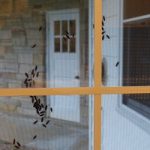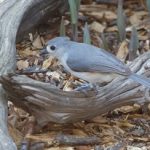by Winding Pathways | Mar 14, 2017 | Nature, Pests

All this winter box elder bugs have gathered on warm sunny sides of homes.
Lots of box elder bugs are traipsing through homes this winter to the consternation of human occupants.
This amazingly common and crafty insect is a true bug named for common box elder trees. You don’t have to have box elder trees nearby to “enjoy” visits by the bug. Maple and ash trees of several species make a suitable hosts. Since these trees are everywhere in suburbia it’s no wonder box elder bugs pester so many people. Box elder bugs make their living feeding on tree seeds and sap but they don’t pose a threat to their host. Unlike the pests of many other trees box elder bugs don’t kill trees.
Come fall, box elder bugs prepare for cold weather by tucking themselves into bark crevices to patiently wait out the cold. However, they would rather be warm and if a house is nearby they seem to sense that soon the furnace will be going and indoors is the best place to overwinter,.
Although they are fairly large insects box elder bugs can crawl through tiny cracks and holes. Often they swarm in the sun on the exterior of a house and some manage to find their way inside. Winter is spent idly exploring light fixtures, furniture, and walls.
They are not really a serious pest. Pesky might be a better way to describe them. Box elder bugs neither bite nor sting. They do sometimes crawl on people and pets. Perhaps their most disagreeable characteristics are pooping and emitting a disagreeable odor if they are crushed. It’s this bad odor that protects them from predators. Hardly anything will eat a box elder bug.
Want to rid the house of box elder bugs? The best defense is a caulking gun. Late each summer seal up cracks that allow them to squeeze into the house. Any found wandering around inside can be vacuumed up, and a shop vac can suck up hundreds sunning on the exterior. Dump them in soapy water and they’ll quickly drown. A hose can also knock them off an exterior wall. Insecticides kill them but perhaps insecticides create more problems than they solve. Some people report that spraying box elder bugs with soapy water also kills them.
Box elder bugs aren’t harmful, but they are pesky and goofy. Caulking up home cracks can encourage them to winter outdoors in trees, rather than inside with you.
#
by Winding Pathways | Mar 7, 2017 | (Sub)Urban Homesteading, Flowers/Grasses, Foraging, Nature, Weeds
As soon as a few warm days arrive early each spring we search our yard at Winding Pathways for two of our favorite plants – Stinging Nettles and Dandelions.
To most people they’re weeds. To us they’re delicious yard gifts.
STINGING NETTLES
Stinging nettles are one of the tastiest of all wild greens. They begin growing very early each spring and are usually ready to pick about the time when gardeners plant spinach and lettuce. In Iowa that’s sometime in April. Nettles love moist soil at the edge of woods where they receive partial shade. Often they’re common on yard edges. Nettles are well named, because they can sting! Another name for the plant is “three minute itch”, because the slight stinging sensation is just temporary. There’s a way to avoid the “itch.”
We pick nettles when they are only a couple of inches tall. To avoid the sting, we either wear light gloves or carefully pluck off the top few leaves between the thumb and forefinger. About 100 leaves are plenty for dinner for the two of us. We bring the plucked nettles into the kitchen, rinse them well, and boil them for just a few minute. It’s really more like steaming them as we only put about a half inch of water in the pan. Once steamed the sting disappears. Put a dollop of butter on them with a sprinkle of vinegar and enjoy as the year’s first green crop.
We continually pick from the same nettle patch and each plant constantly creates new leaves at the growing tip. This extends the picking season for over a month, and by then our spinach is ready to harvest from the garden. For the rest of the growing season, foraging insects enjoy the nectar of the nettles.
DANDELIONS
Almost everyone knows that dandelions are edible but most people who try them quickly toss the bitter plants out and never try again. Take heart and try again! Dandelions are revered in many eastern cities where Italians live. Festivals abound across the country “…from the Redwood forests to the Gulf Stream waters….” (apologies to Woody Guthrie) and the Amana Colonies in Iowa are known for their dandelion wines. Google Dandelion Festivals to find one near you. One coming up for St. Patrick’s Day is Dandelion Days in California.
Dandelions are delicious but there’s a trick to enjoying them. The best ones are picked in very early spring when the leaves are brand new. Those poking out from under leaves are semi blanched, lack bitterness, and are delicious and packed with vitamins. As soon as dandelion leaves are full size they are too bitter to eat without special processing. Young blanched leaves can be eaten raw in salad or steamed.
A CAUTION
Before eating any wild plant for the first time make sure you correctly identify it, using at least two sources for identification……….an expert forager and a wild food book, or a wild food book and a credible website, for example. Our all-time favorite source for wild food information is Euell Gibbons’ classic book STALKING THE WILD ASPARAGUS. If you spot one at a used book sale snap it up as quickly as you do fresh nettles. Some helpful websites include Eat the Weeds , Eat the Weeds You Tube Videos, and Food52. Episode 134 of Eat the Weeds features neighborhood foraging. At about six minutes, Green Deane, the host, shows and talks about dandelions.
by Winding Pathways | Feb 28, 2017 | Birds, Nature
Nearly everyone who feeds birds across the eastern United States enjoys luring

The tufted titmouse is a year round resident in much of the Eastern United States. It’s late winter call is a sure sign of spring.
the black capped chickadee, white breasted nuthatch, downy woodpecker, goldfinch, and cardinal to the yard. All are fascinating nonmigrating birds of deciduous forests and suburbia. We love all these birds but especially enjoy the tufted titmouse.
The titmouse also loves living in suburban areas and wooded places. It’s a homebody that doesn’t migrate, so they can be seen all year. However,titmice are most commonly spotted when visiting feeders for meals of sunflower seeds.
The titmouse has a more limited range than chickadees or nuthatches. At Winding Pathways in Eastern Iowa we are near the northern and western edge of their range. From Iowa they range east to the Atlantic Ocean and south from New England to the Gulf of Mexico.
A titmouse has a surprisingly loud voice for such a small bird. We enjoy hearing them as we walk in our yard. To learn more about this beautiful bird, and to enjoy its song go to the Cornell University Laboratory of Ornithology’s website.
by Winding Pathways | Feb 20, 2017 | Birds, Nature, Pests
A recent article in LIVING BIRD Magazine reported that cats kill more than 2.4 billion birds each year in the United States. Their numbers came from the book, CAT WARS, by Peter Marra and Chris Santella.
use cats are fascinating animals that are loved by 600 million people worldwide who keep one or more as pets. They’ve been part of the human experience since at least the dawn of agriculture. Descended from a species that remains wild in Saudi Arabia, Israel, and other Middle Eastern countries, cats were informally domesticated as early as 10,000 years ago. Probably the earliest semi tame cats were wild individuals who lived near cultivated fields and hunted mice and other pests. At some point people began taking them into their homes as pets.
House cats followed humans as they spread around the globe and today are common wherever people live. Unlike many domestic animals that long ago lost their ability to survive in the wild, cats often go wild. These “feral” animals have a high reproductive rate and can create a large wild population in a relatively short time. Often these colonies of feral cats prey on animals that have no defense against them.
Cats never lost their ability to hunt and continue to catch animals, especially mice and other small mammals. Unfortunately they are also effective bird predators. Cats kill more birds than collisions with buildings, power lines, and wind turbines combined. They pose a serious threat to some bird populations.
There is a simple way that cat lovers can enjoy their pet while reducing the impact of these fascinating animals on birds…….keep them indoors.
For more information:
Cat Wars: The Devastating Consequences of a Cuddly Killer. Princeton University Press.
The Cornell University Laboratory of Ornithology.
*Note: Winding Pathways is not paid by companies we feature.
by Winding Pathways | Jan 30, 2017 | Mammals, Nature

These big cats have over 40 names. (Courtesy NYPL free digital file.)
Early one December evening a neighbor was driving home near our home when she spotted movement out of the corner of her eye. Thinking a deer was about to dart in front of her car, she immediately stopped to prevent a collision. She was astounded when a mountain lion crossed about ten feet in front of her illuminated by headlights.
A mountain lion………in Iowa! Perhaps that’s not so farfetched. Our neighbor would know one when she saw it.
Mountain lions (Puma concolor) are spreading out from their traditional home in western mountains. A couple of decades ago the only known eastern population of the big cats was in Florida, where they are extremely rare and are usually called panthers. These big cats were once common throughout North America except for the far north. They also ranged throughout all of Central and most of South America. As big predators they were heavily persecuted by humans, and their habitat was devastated by settlement. A big blow to cougars was the elimination of deer from much of their range in the late 1800’s.
Much has changed to give lions, or cougars as they are sometimes called, an opportunity to expand.
Most people now appreciate them as beautiful animals and don’t shoot them on sight. Many states protect them from shooting. Also, the woods and deer have returned. In 1900 most of what today is a vast hardwood forest that stretches from the Mississippi River to the Atlantic Ocean was farmed. Many of those farms went out of business and trees move in. Today, there’s near continuous forest for hundreds of miles and much of it is filled with deer, a favorite food of mountain lions.
A few years ago a male cougar walked from his Black Hills home to Connecticut, where he was hit and killed by a car. Most Midwest states have documented the presence of cougars. A few have been hit by cars. More have been photographed by trail cameras put out by hunters to track deer movement. Some have been shot. Seeing a live one is very rare.
So, a cougar sighting near Winding Pathways in Iowa is neither impossible nor surprising. It was probably a young male cat seeking a mate and place to live.
Do mountain lions pose a threat to people, livestock, or pets? Not really. There have been documented cougar attacks on people, mostly in California where they are not hunted and have lost fear of people, but the risk in most places is trivial. Cougars are shy animals that choose to stay out of sight and prefer eating deer to dogs, sheep, cattle, and cats.
We wish we’d seen the mountain lion that passed through our neighborhood but he’s probably miles away by now.
This is an independently researched column. No money or goods have been exchanged for this information.
by Winding Pathways | Jan 20, 2017 | Amphibians/Reptiles, Children/Play, Nature, Wonderment
Almost all substances contract as they get colder. There’s one notable exception and it enables life.

Ice expands and floats
As water cools, it gets denser. As the temperature continues to drop, cold surface water sinks to the bottom. When the lake’s surface water reaches 39 degrees Fahrenheit something amazing happens. As weather continues to get colder it expands. When it turns to ice it expands even more! That’s why ice floats. If it didn’t, ponds and lakes would completely freeze and nothing could live in a solid block of ice.
Ice floating on a lake moderates the temperature of the water beneath it. Although the air temperature may be below zero above the ice the water beneath it is never below freezing. That’s why fish, frogs, and other aquatic organisms can not only live but also bask in the relative warmth of the water while terrestrial animals are forced to survive in arctic cold.
This phenomenon makes ice fishing possible. The following blog was written by a friend who took her children fishing one cold morning.
Ice Fishing With Kids
Story and photos of people
by: Kelly Carr
“They weren’t budging. Even with the overhead light flipped on, gentle shoulder shakes, and promises of the fun they would have, my kids feigned sleep. It was 7:00 a.m. on New Year’s Eve, and it had been about a year since our last ice fishing attempt. This particular day was the sixth of a seven day stretch of the new shared-custody arrangement I had with my daughter and son’s father. As if putting them through a divorce wasn’t guilt-inducing enough, now I was trying to drag them out of the security of their warm beds. My mind drifted back to the present – if I could just get them going, I knew they would have a great time. So, I played the “Let’s Get Donuts On The Way” card. Sleeping forms shifted, eyelids sprung open. We were out the door in fifteen minutes, teeth unbrushed, bedhead tucked under stocking caps, and feet snuggled into a double layer of socks.”
Donut Bribery works!
“I’ve tried to raise kids who feel comfortable in nature. Driving to the park for the ice fishing clinic, the car filled with the smell of maple frosting. I mused silently upon some of our past outdoor adventures. We have been geocaching newbies, tramping at a roadside park, looking for a “small bison container”, which, as it turned out, was NOT a buffalo figurine after all! We’ve packed picnics into cemeteries, and talked oaks and stones and stories while we ate.
“A voice from behind jostled me back to the present. I passed a cappuccino to waiting hands in the backseat and then pointed up to a hillside, “Look – a cemetery!” My daughter protested, “Not today, Mom! Ugh!” You win some, you lose some.
The Outdoor Thing
“We wound through the park to the shore. After a quick presentation by a naturalist and distribution of fishing guides, bait and poles, we were set. My kids chose spots not too far away from their last year’s spots, got settled in on mats and sipped from their gas station cups while waiting for spring-bobbers to bob. The sun made things sparkle, and as I looked at them handling things and sitting in peace, I knew I had nothing to feel guilty about. Tummies full, bundled in warm layers, taking a chance on adventure, we were doing this “outdoors thing”. And we were finding our new “normal” while doing it. They each pulled two fish out of the water that morning before asking to go back to the car to listen to music. I consider that as success.

Smiles

A warm bed is no match for the coolness of catching a panfish in winter.
“I had a few moments to myself out on the ice, to take it all in. Even when life changes, there are constants we can count on. The fish may not always bite, but while the sky is above and the earth (or ice) is below, I am a mother who loves her kids.”






